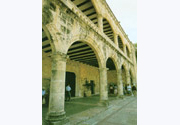Dominican Republic

- © UNESCO
- Colonial City of Santo Domingo
The Dominican Republic became a member of UNESCO on November 4, 1946. The country is covered by UNESCOís Regional Office in Havana, a Cluster Office also covering Cuba, Haiti and Aruba.
Following Christopher Columbusí discovery of the Dominican Republic in 1492, it was in Santo Domingo that were founded the first cathedral, the first hospital, the first customs house and the first university of the Americas. The colonial city was built on a checkerboard street plan that became the model for nearly all urban planners in the New World, the reason for which the city was listed on the World Heritage List in 1990.
The Cultural Space of the Brotherhood of the Holy Spirit of the Congos of Villa Mella was proclaimed a Masterpiece of the Oral and Intangible Heritage of Humanity in 2001, as was the Cocolo Dance Drama Tradition in 2005.
The Dominican Republic is involved in the project aimed at preserving Caribbean sites related to the slave trade, the current phase of the Slave Route Project.
The country plays an important role in the Man and Biosphere (MAB) Programme, which it joined in 2002. It is active in the IBEROMAB network, linking all the Latin American countries.
The Dominican Republic participates in the Caribbean Coastal Marine Productivity Program, sustaining coastal biodiversity benefits, as well as other projects concerned with island and coastal issues.
The country holds two UNESCO Chairs, including a UNESCO Chair for peace, human rights and democracy, established in 1998 at the Autonomous University of Santo Domingo.
UNESCOís Director-General KoÔchiro Matsuura visited the Dominican Republic in March 2004.

